Bulletin – June 2018 Australian Economy Banking Fees in Australia
- Download 343KB

Abstract
The Reserve Bank has conducted a survey on bank fees each year since 1997. The most recent survey suggests that banks' fee income from both households and businesses rose in 2017, due to a combination of growth in the volume of services for which fees are charged and higher unit fees on some products. Deposit fee income continued to decline relative to the value of outstanding deposits, while lending fee income as a share of assets was steady. Greater use of electronic payment methods continued to support strong growth in merchant service fee income.
Overview
The Reserve Bank's annual bank fee survey provides information on the fees earned by banks through their Australian operations.[1] The survey focuses on fee income generated through the provision of loans, deposit services and payment services. The 2017 survey included 16 institutions, capturing 90 per cent of the Australian banking sector by balance sheet size.[2] Fees earned from operations outside of Australia and other fee income obtained through funds management and insurance operations are not covered by the survey. This article summarises the results from the latest survey, covering banks' financial years ending in 2017.[3]
In 2017, domestic banking fee income grew by 3.6 per cent to around $13 billion (Table 1). This reflected increases in fees paid by both households and businesses, driven by a combination of volume growth and increases in some unit fees. However, relative to the value of outstanding deposits, deposit fee income continued to decline while lending fee income was steady as a share of banks' assets (which includes loans) (Graph 1).
| Households | Businesses | Total | ||||
|---|---|---|---|---|---|---|
| Level $ million |
Growth Per cent |
Level $ million |
Growth Per cent |
Level $ million |
Growth Per cent |
|
| 2014 | 4,197 | 1.7 | 7,848 | 3.3 | 12,045 | 2.9 |
| 2015 | 4,381 | 4.4 | 8,124 | 3.5 | 12,505 | 3.8 |
| 2016(a) |
4,367 | –0.3 | 8,225 | 1.2 | 12,592 | 0.7 |
| 2017 | 4,500 | 3.1 | 8,541 | 3.8 | 13,041 | 3.6 |
|
(a) Fee income from households in 2016 was affected by a transfer of assets Source: RBA |
||||||

Households
Banks' fee income from households grew by 3.1 per cent in 2017, reflecting strong growth in fee income from credit cards (Graph 2; Table 2). Growth in fee income from housing and personal loans was moderate.[4] Fee income from deposit products rose a little in 2017, after declining in the previous two years.
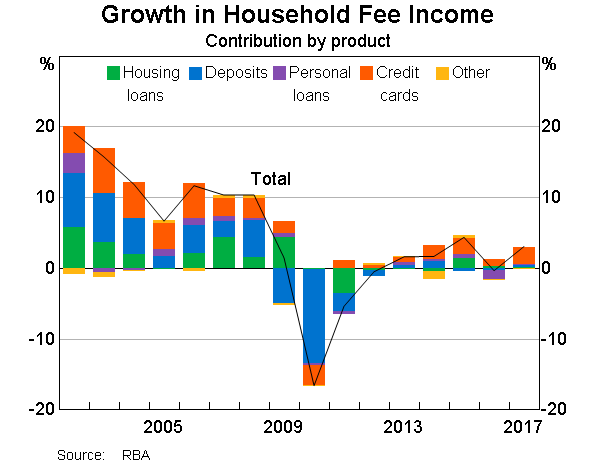
| 2015 $ million |
2016 $ million |
2017 $ million |
Annual growth 2017 Per cent |
Average annual growth 2011–16 Per cent |
|
|---|---|---|---|---|---|
| Loans: | 3,164 | 3,164 | 3,278 | 3.6 | 2.1 |
| – Housing | 1,259 | 1,272 | 1,277 | 0.4 | 0.7 |
| – Personal(a) |
391 | 332 | 337 | 1.4 | 0.2 |
| – Credit Cards | 1,513 | 1,560 | 1,665 | 6.7 | 3.8 |
| Deposits | 1,144 | 1,134 | 1,150 | 1.4 | –0.1 |
| Other Fees(b) |
74 | 69 | 65 | –5.7 | –5.4 |
| Total | 4,381 | 4,367 | 4,500 | 3.1 | 1.4 |
|
(a) Fee income from personal loans in 2016 was affected by a transfer
of assets Source: RBA |
|||||
Fee income from credit cards continued to be the largest single source of banks' fee income from households. The increase in fee income from credit cards in 2017 was driven by an increase in income from foreign currency conversion fees – which reflected higher transaction volumes – and income from late payment fees. Account-servicing fee income also increased, with some banks reinstating annual fees for products where these fees had previously been waived. In addition, there was a strong increase in unit fees on credit cards, with some banks increasing annual fees on both rewards and non-rewards cards (Table 3).
| 2015 | 2016 | 2017 | Annual growth 2017 Per cent |
|
|---|---|---|---|---|
| Annual fees ($) | ||||
| Non-rewards cards(b) |
53 | 53 | 60 | 13.0 |
| Rewards cards | 185 | 191 | 199 | 4.5 |
| All cards | 133 | 137 | 147 | 7.3 |
| Other fees | ||||
| Foreign currency conversion fees (per cent of value) |
2.9 | 2.8 | 2.8 | –2.5 |
| Late payment fee ($) | 17 | 18 | 19 | 5.9 |
|
(a) Simple average of advertised fees for cards issued by a sample of
seven banks; only cards that are available to new cardholders are included
in the sample; note that changes in the sample affect the average fee;
includes fee-free cards; does not include any fee waivers or reductions
; as at June of each year Sources: Credit card issuers' websites; RBA |
||||
Income from exception fees charged to households on credit card products rose slightly in 2017, after declining since 2013 (Graph 3). In aggregate, this partly reflected a rise in late payment fees charged, due to a combination of an increase in unit fees charged and higher fee collection rates from customers. However, this trend was not broadly based across banks; some banks reported lower income from over-limit and late payment fees resulting from a gradual change in customer behaviour relating to credit card use.
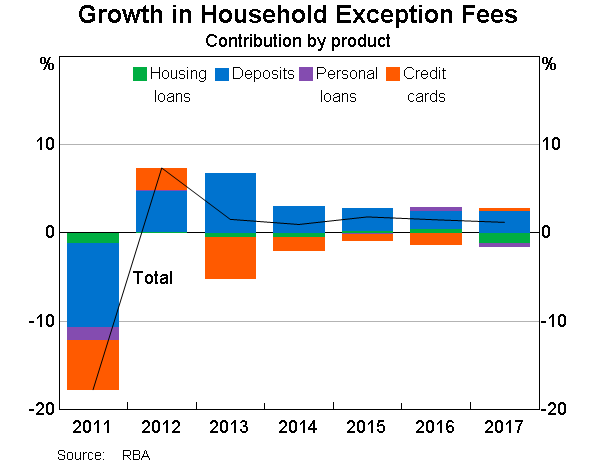
Fee income from housing loans was little changed in 2017, despite loan approvals having increased over the year. Some banks continued to waive loan establishment fees, partly offsetting the rise in fee income due to higher lending volumes. Income from exception fees related to housing loans – which includes dishonour, late payment and break fees – declined in 2017, although the magnitude of the fall was exacerbated by a change in treatment at one institution.
Fee income from deposits increased in 2017, after falling in the two preceding years. A rise in overdrawn account charges and stop payment fees contributed to the increase in transaction deposit fee income. Some banks reported a decline in transaction fees in 2017, which in part reflected decisions by a number of banks to remove ATM withdrawal fees.[5] Fee income from non-transaction accounts, such as term deposits and online savings accounts, also rose in 2017.
Businesses
Total fee income from businesses increased by 3.8 per cent in 2017, entirely reflecting higher fee income from small businesses (Graph 4; Table 4). Growth in fee income was driven by increases in merchant service fees on card transactions and account servicing fees on small business loans. Fee income from deposit accounts and from other sources (such as fees related to bank guarantees and overseas transactions) also increased, while fee income from bank bills continued to decline (Graph 5). The four major banks continued to account for around 90 per cent of the fee income earned from small and large businesses by the banks included in the survey.
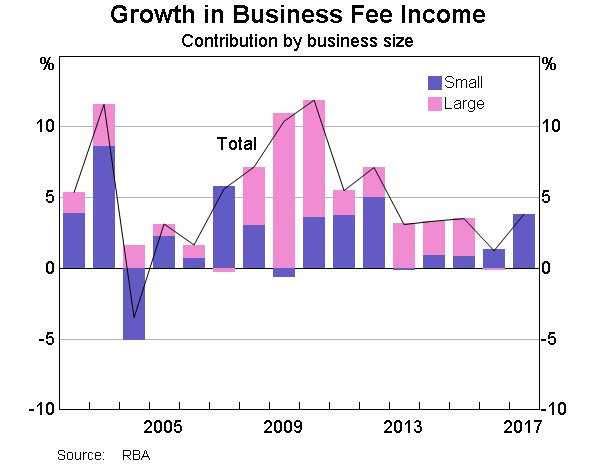
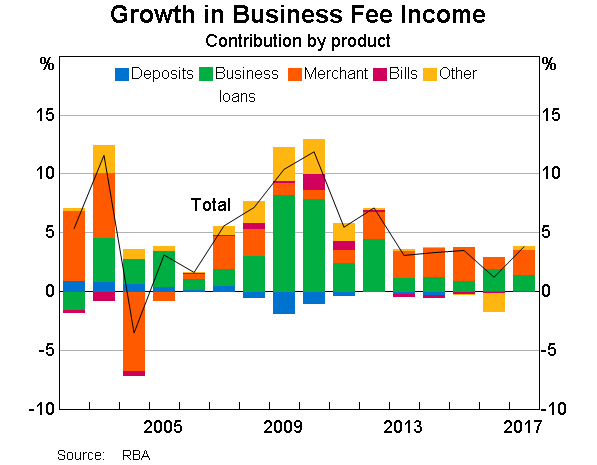
| 2015 $ million |
2016 $ million |
2017 $ million |
Annual growth 2017 Per cent |
Average annual growth 2011–16 Per cent |
|
|---|---|---|---|---|---|
| Deposit accounts | 587 | 593 | 599 | 1.0 | –1.0 |
| – of which: exception fees | 41 | 60 | 62 | 4.4 | 3.8 |
| Loans | 3,433 | 3,585 | 3,697 | 3.1 | 4.5 |
| – of which: exception fees | 42 | 53 | 48 | –9.9 | –4.1 |
| Merchant service fees | 2,651 | 2,734 | 2,909 | 6.4 | 7.4 |
| Bank Bills | 190 | 179 | 176 | –1.7 | –5.0 |
| Other(a) |
1,263 | 1,135 | 1,160 | 2.2 | –1.7 |
| Total | 8,124 | 8,225 | 8,541 | 3.8 | 3.6 |
| – of which: exception fees | 83 | 113 | 110 | –2.3 | 5.1 |
|
(a) Includes banking-related fee income from businesses that cannot be directly related to a deposit or loan account, merchant or bank bill facility (e.g. guarantees or foreign exchange fees) Source: RBA |
|||||
The increase in fee income from business loans in 2017 reflected higher fee income from small businesses, while fee income from loans to large businesses fell. The increase in fee income from small businesses was driven by an increase in account servicing fees attributed to growth in lending volumes, which is consistent with the relatively strong growth in lending to smaller businesses over 2017.
Growth in merchant service fee income in 2017 was driven by fees charged to small businesses for accepting card transactions; there was a more moderate increase in merchant service fee income from large businesses. Banks reported that the increase in merchant service fees reflected higher transaction volumes on payment cards rather than an increase in fee rates, with consumers continuing to increase their use of non-cash payment methods (RBA 2017). Consistent with these observations, the ratio of merchant service fee income to credit and debit card transactions was relatively stable in 2017, as it has been over the past few years (Graph 6). Non-transaction merchant fee income (such as set-up fees, annual fees, and terminal rental costs) also grew strongly in 2017. Looking ahead, banks' merchant service fee income is likely to be affected by the development of terminal functionality that allows businesses to direct contactless debit card payments to their lowest-cost processing network (RBA 2018).
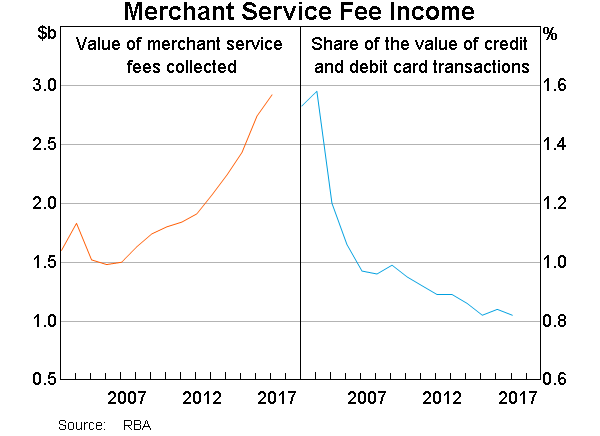
Bank bill fee income declined in 2017, driven by lower fee income from small businesses. This reflected a broad shift away from the use of bank bills as banks continue to encourage customers to transition to traditional lending products.
Fee income from business deposits increased slightly, driven by higher volumes of large business deposits. In contrast, deposit fee income from small businesses, which accounted for around two-thirds of business deposit fee income, was a little lower in 2017.
Conclusion
Growth in banks' aggregate fee income has been relatively stable since 2010. By product, this trend primarily reflects relatively stable aggregate fee income from deposits while aggregate loan fee income has risen steadily. Fee income from businesses has grown more rapidly than fee income from households over this time. The increasing use of electronic payment methods has driven strong growth in both fee income from households on credit card products and merchant service fee income from businesses over the past five years.
Footnotes
The authors are from Domestic Markets Department [*]
The data from the survey are published in the Reserve Bank's Statistical Table C9, ‘Domestic Banking Fee Income’ and are subject to revision on the advice of participating banks. [1]
Survey results have been affected by mergers and acquisitions among participating institutions and some changes in participants' methodology (where possible, this has been reflected in revisions to data reported in previous years). [2]
Apart from Table 3, all data from the survey are based on individual banks' financial years, which differ across banks. [3]
The personal loan category includes fees associated with term loans, margin loans to households, and home-equity loans where the predominant purpose is not known; the category excludes credit card lending. [4]
For more information on developments in the ATM industry, see Mitchell and Thompson (2017). [5]
References
Mitchell S and C Thompson (2017), ‘Recent Developments in the ATM Industry’, RBA Bulletin, December, pp 47–54.
RBA (Reserve Bank of Australia) (2017), Payments System Board Annual Report 2017, pp 31–32.
RBA (2018), ‘Payments System Board Update: May 2018 Meeting’, Media Release No 2018-12, 18 May.